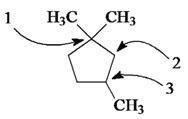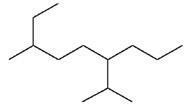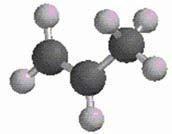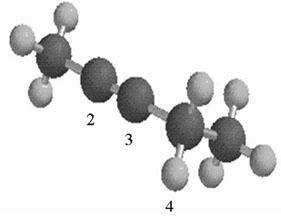1.Alkanesarecharacterizedbythegeneralmolecularformula:
A. C nH2n-2
B. C nH2n
C.C nH2n+2
C. C nH2n+4
Accessibility:KeyboardNavigation
Bloom'sLevel:1.Remember
Chapter:02
Difficulty:Easy
Gradable:automatic
Section:02.05
Subtopic:Acyclicvscyclic
Subtopic:Alkanes
Subtopic:Hydrocarbons
Topic:Alkanes(AcyclicandCyclic)
Topic:FunctionalGroups
2.Cycloalkanesarecharacterizedbythegeneralmolecularformula:
A. C nH2n-2
B. C nH2n
C.C nH2n+2
D. C nH2n+4
Accessibility:KeyboardNavigation
Bloom'sLevel:1.Remember
Chapter:02
Difficulty:Easy
Gradable:automatic
Section:02.18
Subtopic:Acyclicvscyclic
Subtopic:Alkanes
Subtopic:Hydrocarbons
Topic:Alkanes(AcyclicandCyclic)
Topic:FunctionalGroups
Copyright©2016McGraw-HillEducation.Allrightsreserved.Noreproductionordistributionwithoutthepriorwrittenconsentof McGraw-HillEducation.
3.Thecarbon-carbonsigmabondinethaneisformedbyoverlapofwhichtwoorbitals?
D.sp 3 -sp 3
Accessibility:KeyboardNavigation
Bloom'sLevel:2.Understand
Chapter:02
Difficulty:Medium
Gradable:automatic
Section:02.07
Subtopic:Hybridization
Topic:MolecularShape
Copyright©2016McGraw-HillEducation.Allrightsreserved.Noreproductionordistributionwithoutthepriorwrittenconsentof McGraw-HillEducation.

A.4,4-dimethylpentane
B.1-tert-butylpropane
C.2,2-dimethylpentane
D.1,1,1-trimethylbutane
Bloom'sLevel:3.Apply Chapter:02
Difficulty:Medium
Gradable:automatic
Section:02.17
Subtopic:IUPACNomenclatureofacyclicalkanes
Topic:Alkanes(AcyclicandCyclic)
Copyright©2016McGraw-HillEducation.Allrightsreserved.Noreproductionordistributionwithoutthepriorwrittenconsentof McGraw-HillEducation.

A.2-ethyl-3,5-dimethylheptane. B.6-ethyl-5,5-dimethylheptane. C.3,4,4-trimethyloctane. D.5,5,6-trimethyloctane.
Bloom'sLevel:3.Apply
Chapter:02
Difficulty:Medium Gradable:automatic
Section:02.17
Subtopic:IUPACNomenclatureofacyclicalkanes
Topic:Alkanes(AcyclicandCyclic)
6.Thecommonnameofthefollowinggroupis

A.n-butyl
B.sec-butyl
C.isobutyl
D.tert-butyl
Bloom'sLevel:1.Remember
Chapter:02
Difficulty:Medium Gradable:automatic Section:02.16
Subtopic:Alkylgroups
Topic:Alkanes(AcyclicandCyclic)
Copyright©2016McGraw-HillEducation.Allrightsreserved.Noreproductionordistributionwithoutthepriorwrittenconsentof McGraw-HillEducation.
7.Whichoneofthefollowingis2,2,5-trimethylhexane?
A.(CH3)2CHCH2C(CH3)3
B.(CH3)2CHCH2CH2C(CH3)3
C.CH3CH2CH(CH3)C(CH3)3
D.(CH3)2CHCH2CH2CH2C(CH3)3
Accessibility:KeyboardNavigation
Bloom'sLevel:3.Apply
Chapter:02
Difficulty:Medium Gradable:automatic
Section:02.17
Subtopic:IUPACNomenclatureofacyclicalkanes
Topic:Alkanes(AcyclicandCyclic)
8.ThecorrectIUPACnameofthefollowingis

A.2,4,7-trimethylnonane.
B.7-ethyl-2,4-dimethyloctane.
C.3,6,8-trimethylnonane.
D.2-ethyl-5,7-dimethyloctane.
Bloom'sLevel:3.Apply Chapter:02
Difficulty:Medium Gradable:automatic
Section:02.17
Subtopic:IUPACNomenclatureofacyclicalkanes
Topic:Alkanes(AcyclicandCyclic)
Copyright©2016McGraw-HillEducation.Allrightsreserved.Noreproductionordistributionwithoutthepriorwrittenconsentof McGraw-HillEducation.
9.WhatistheIUPACnameofthefollowing?

A.5,6-diethylhexane
B.5-ethyl-6-methylheptane
C.2,3-diethylhexane
D.4-ethyl-3-methylheptane
Bloom'sLevel:3.Apply
Chapter:02
Difficulty:Medium
Gradable:automatic
Section:02.17
Subtopic:IUPACNomenclatureofacyclicalkanes
Topic:Alkanes(AcyclicandCyclic)
10.WhatistheIUPACnameofthefollowing?

A.1-ethyl-4.4-dimethylcyclopentane
B.1-ethyl-3,3-dimethylcyclopentane
C.3-ethyl-1,1-dimethylcyclopentane
D.4-ethyl-1,1-dimethylcyclopentane
Bloom'sLevel:3.Apply
Chapter:02
Difficulty:Medium Gradable:automatic
Section:02.18
Subtopic:IUPACNomenclatureofcycloalkanes
Topic:Alkanes(AcyclicandCyclic)
Copyright©2016McGraw-HillEducation.Allrightsreserved.Noreproductionordistributionwithoutthepriorwrittenconsentof McGraw-HillEducation.
11.Cyclohexaneiscomposedof
A.methinegroups.
B.methylenegroups. C.methylgroups. D.bothmethineandmethylenegroups.
Accessibility:KeyboardNavigation
Bloom'sLevel:2.Understand Chapter:02
Difficulty:Medium
Gradable:automatic Section:02.11
Subtopic:IUPACNomenclatureofcycloalkanes Topic:Alkanes(AcyclicandCyclic)
12.Allthecarbonsincyclopentaneare
A.primarycarbons. B.secondarycarbons. C.tertiarycarbons. D.quaternarycarbons.
Accessibility:KeyboardNavigation
Bloom'sLevel:2.Understand Chapter:02
Difficulty:Medium Gradable:automatic Section:02.16
Subtopic:IUPACNomenclatureofcycloalkanes Topic:Alkanes(AcyclicandCyclic)
Copyright©2016McGraw-HillEducation.Allrightsreserved.Noreproductionordistributionwithoutthepriorwrittenconsentof McGraw-HillEducation.

A.(1-methylpropyl)cyclohexane.
B.(2-methylpropyl)cyclohexane. C.(2,2-dimethylethyl)cyclohexane. D.(2,2-dimethylpropyl)cyclohexane.
Bloom'sLevel:3.Apply
Chapter:02
Difficulty:Medium
Gradable:automatic
Section:02.18
Subtopic:IUPACNomenclatureofcycloalkanes
Topic:Alkanes(AcyclicandCyclic)
Copyright©2016McGraw-HillEducation.Allrightsreserved.Noreproductionordistributionwithoutthepriorwrittenconsentof McGraw-HillEducation.

A.(1-methylhexyl)cyclopentane.
B.(1-pentylethyl)cyclopentane.
C.2-cyclopentylheptane.
D.1-cyclopentyl-2-heptane.
Bloom'sLevel:3.Apply
Chapter:02
Difficulty:Medium
Gradable:automatic
Section:02.18
Subtopic:IUPACNomenclatureofcycloalkanes
Topic:Alkanes(AcyclicandCyclic)
15.TheC-Csigmabondinacetyleneisformedbytheoverlapofwhichtwoorbitals?

A.2p-2p
B.sp-sp
C.sp2-sp2
D.sp3-sp3
Bloom'sLevel:2.Understand Chapter:02
Difficulty:Medium
Gradable:automatic
Section:02.09
Subtopic:Hybridization
Topic:MolecularShape
Copyright©2016McGraw-HillEducation.Allrightsreserved.Noreproductionordistributionwithoutthepriorwrittenconsentof McGraw-HillEducation.
A.weakerintermolecularvanderWaalsforces.
B.strongerintermolecularvanderWaalsforces. C.weakerdipole-dipoleattractiveforces. D.strongerdipole-dipoleattractiveforces.
Accessibility:KeyboardNavigation
Bloom'sLevel:2.Understand Chapter:02
Difficulty:Medium Gradable:automatic Section:02.21
Subtopic:Intermolecularforces
Topic:FunctionalGroups
17.Whichofthefollowingdescribesanatomorgroupofatomsthathassimilar chemicalpropertieswhenitoccursindifferentcompounds?
A.hydrocarbon
B.functionalgroup
C.paraffin
D.isomer
Accessibility:KeyboardNavigation
Bloom'sLevel:1.Remember Chapter:02
Difficulty:Easy
Gradable:automatic Section:02.19
Subtopic:C-Zfunctionalgroups(Z=N,O,S,halogen)
Subtopic:Hydrocarbons Topic:FunctionalGroups
2-10
Copyright©2016McGraw-HillEducation.Allrightsreserved.Noreproductionordistributionwithoutthepriorwrittenconsentof McGraw-HillEducation.
18.Arrangethefollowingisomericalkanesinorderofincreasingboilingpoint.
II.2,3-dimethylpentane
III.2,2,3-trimethylbutane
A.I<II<III
B.II<III<I
C.III<I<II
D.III<II<I
Accessibility:KeyboardNavigation
Bloom'sLevel:4.Analyze Chapter:02
Difficulty:Medium
Gradable:automatic
Section:02.21
Subtopic:Intermolecularforces
Topic:FunctionalGroups
19.Theoxidationstatesofcarbonrangefrom
A.0to+2.
B.0to+4.
C.-4to0.
D.-4to+4.
Accessibility:KeyboardNavigation
Bloom'sLevel:1.Remember Chapter:02
Difficulty:Easy
Gradable:automatic
Section:02.23
Subtopic:Acyclicvscyclic Topic:Alkanes(AcyclicandCyclic)
2-11
Copyright©2016McGraw-HillEducation.Allrightsreserved.Noreproductionordistributionwithoutthepriorwrittenconsentof McGraw-HillEducation.
20.Whichofthefollowinghas(have)ahigheroxidationstateofcarbonthanthecarbonin formaldehyde,H2C=O?
A.I
B.III
C.IIandIII
D.I,II,andIII
Accessibility:KeyboardNavigation
Bloom'sLevel:4.Analyze Chapter:02
Difficulty:Medium
Gradable:automatic
Section:02.23
Subtopic:Acyclicvscyclic Topic:Alkanes(AcyclicandCyclic)
21.Thetert-butylgroupcanalsobecalled
A.1,1-dimethylpropyl.
B.1,1-dimethylethyl.
C.2,2-dimethylpropyl.
D.2,2-dimethylethyl.
Accessibility:KeyboardNavigation
Bloom'sLevel:2.Understand Chapter:02
Difficulty:Medium
Gradable:automatic Section:02.16
Subtopic:Alkylgroups Topic:Alkanes(AcyclicandCyclic)
2-12
Copyright©2016McGraw-HillEducation.Allrightsreserved.Noreproductionordistributionwithoutthepriorwrittenconsentof McGraw-HillEducation.
22.Carbonatoms1,2,and3inthefollowingstructureareclassified,respectively,as

A.tertiary,primary,secondary. B.quaternary,secondary,secondary. C.quaternary,primary,tertiary. D.quaternary,secondary,tertiary.
Bloom'sLevel:2.Understand Chapter:02
Difficulty:Medium Gradable:automatic Section:02.16
Subtopic:Alkylgroups Topic:Alkanes(AcyclicandCyclic)
23.IdentifytheisomerofC6H14thatonlyhasprimaryandtertiarycarbons.
A.hexane
B.2,2-dimethylbutane
C.3-methylpentane
D.2,3-dimethylbutane
Accessibility:KeyboardNavigation
Bloom'sLevel:3.Apply Chapter:02
Difficulty:Hard
Gradable:automatic
Section:02.16
Subtopic:IUPACNomenclatureofacyclicalkanes Topic:Alkanes(AcyclicandCyclic)
2-13
Copyright©2016McGraw-HillEducation.Allrightsreserved.Noreproductionordistributionwithoutthepriorwrittenconsentof McGraw-HillEducation.
24.Whycanheatsofcombustionofconstitutionalisomersofhydrocarbonsbeusedto measuretheirstabilities?
I.Combustionofconstitutionalisomersgivesdifferentfinalstates.
II.Combustionofconstitutionalisomersgivesthesamefinalstates.
III.Constitutionalisomersofhydrocarbonshavethesamepotentialenergies.
IV.Constitutionalisomersofhydrocarbonshavedifferentpotentialenergies.
A.onlyI
B.onlyII
C.IandIII
D.IIandIV
Accessibility:KeyboardNavigation
Bloom'sLevel:2.Understand Chapter:02
Difficulty:Medium
Gradable:automatic Section:02.22
Subtopic:Reactionsofalkanes Topic:Alkanes(AcyclicandCyclic)
25.Theheatsofcombustion(-∆H ° )ofheptaneand3,3-dimethypentaneare4,817and4,809 kJ/mol,respectively.Whichstatementistrue?
A.Heptaneis8kJ/molmorestablethen3,3-dimethylpentane.
B.3,3-Dimethylpentaneis8kJ/molmorestablethanheptane.
C.Stabilitiescannotbecomparedsincetheyarenotisomers.
D.Stabilitiescannotbecomparedsincetheygivedifferentcombustionproducts.
Accessibility:KeyboardNavigation
Bloom'sLevel:2.Understand Chapter:02
Difficulty:Medium
Gradable:automatic Section:02.22
Subtopic:Reactionsofalkanes Topic:Alkanes(AcyclicandCyclic)
2-14
Copyright©2016McGraw-HillEducation.Allrightsreserved.Noreproductionordistributionwithoutthepriorwrittenconsentof McGraw-HillEducation.
26.Thereactionofacetylenewithhydrogengasisshownbelow.Whichstatementsaretrue concerningthereaction?

I.Acetyleneisoxidizedtoethane.
II.Acetyleneisreducedtoethane.
III.Carbonchangesoxidationstatefrom-1to-3.
IV.Hydrogen(fromH2)changesoxidationstatefrom0to+1.
A.IandIII
B.IIandIV
C.I,III,andIV
D.II,III,andIV
Bloom'sLevel:2.Understand Chapter:02
Difficulty:Medium
Gradable:automatic
Section:02.23
Subtopic:Reactionsofalkanes
Topic:Alkanes(AcyclicandCyclic)
27.Howmanymethinegroupsarethereinisopropylcyclopentane?
A.one
B.two C.three
D.four
Accessibility:KeyboardNavigation
Bloom'sLevel:2.Understand Chapter:02
Difficulty:Medium Gradable:automatic
Section:02.11
Subtopic:IUPACNomenclatureofacyclicalkanes
Topic:Alkanes(AcyclicandCyclic)
2-15
Copyright©2016McGraw-HillEducation.Allrightsreserved.Noreproductionordistributionwithoutthepriorwrittenconsentof McGraw-HillEducation.
28.WhatisthetotalnumberofconstitutionalisomerswiththeformulaC5H12?
A.two
B.three
C.four
D.five
Accessibility:KeyboardNavigation
Bloom'sLevel:3.Apply
Chapter:02
Difficulty:Medium
Gradable:automatic
Section:02.13
Subtopic:Constitutionalisomers
Topic:DrawingOrganicMolecules
29.WhatistheIUPACnameofthefollowing?

A.6-isopropyl-3-methylnonane
B.2-ethyl-5-isopropyloctane
C.6-propyl-3-methylnonane
D.2-ethyl-5-propyloctane
Bloom'sLevel:3.Apply
Chapter:02
Difficulty:Medium
Gradable:automatic Section:02.17
Subtopic:IUPACNomenclatureofacyclicalkanes
Topic:Alkanes(AcyclicandCyclic)
2-16
Copyright©2016McGraw-HillEducation.Allrightsreserved.Noreproductionordistributionwithoutthepriorwrittenconsentof McGraw-HillEducation.
30.HowmanymolesofO2gaswouldbeconsumedinthecompletecombustionof
0.100moleofC5H12?
A.0.100moleO2
B.0.400moleO2
C.0.800moleO2
D.1.60moleO2
Accessibility:KeyboardNavigation
Bloom'sLevel:4.Analyze
Chapter:02
Difficulty:Hard
Gradable:automatic
Section:02.22
Subtopic:Reactionsofalkanes Topic:Alkanes(AcyclicandCyclic)
31.Thesystematicnameofthefollowinggroupis

A.5-ethyl-2-methylpentyl.
B.1-ethyl-4-methylpentyl.
C.6-methyl-3-heptyl.
D.2-methyl-5-heptyl.
Bloom'sLevel:3.Apply Chapter:02
Difficulty:Medium
Gradable:automatic
Section:02.16
Subtopic:Alkylgroups Topic:Alkanes(AcyclicandCyclic)
2-17
Copyright©2016McGraw-HillEducation.Allrightsreserved.Noreproductionordistributionwithoutthepriorwrittenconsentof McGraw-HillEducation.

A.identicalstructures
B.resonanceforms
C.constitutionalisomers
D.differentcompoundswithdifferentcompositions
Bloom'sLevel:2.Understand Chapter:02
Difficulty:Medium
Gradable:automatic
Section:02.11
Subtopic:Constitutionalisomers
Topic:DrawingOrganicMolecules
Copyright©2016McGraw-HillEducation.Allrightsreserved.Noreproductionordistributionwithoutthepriorwrittenconsentof McGraw-HillEducation.

A.3-propylpentane
B.3-ethylhexane
C.2-ethylheptane
D.4-ethylpentane
Bloom'sLevel:3.Apply
Chapter:02
Difficulty:Medium
Gradable:automatic
Section:02.17
Subtopic:IUPACNomenclatureofacyclicalkanes
Topic:Alkanes(AcyclicandCyclic)
2-19
Copyright©2016McGraw-HillEducation.Allrightsreserved.Noreproductionordistributionwithoutthepriorwrittenconsentof McGraw-HillEducation.
34.Whichofthefollowingareconstitutionalisomers?
I.2,3,3-dimethylhexane
A.IandII
B.IandIII
C.IIandIII
D.theyareallconstitutionalisomers
Accessibility:KeyboardNavigation
Bloom'sLevel:3.Apply Chapter:02
Difficulty:Medium
Gradable:automatic
Section:02.11
Subtopic:Constitutionalisomers
Subtopic:IUPACNomenclatureofacyclicalkanes
Topic:Alkanes(AcyclicandCyclic)
Topic:DrawingOrganicMolecules
35.WhatistheestimatedC-C-Cbondangleinthefollowingmodel?

A.90o
B.109.5o
C.120o
D.180o
Bloom'sLevel:2.Understand Chapter:02
Difficulty:Medium
Gradable:automatic
Section:02.08
Subtopic:Hybridization
Topic:MolecularShape
2-20
Copyright©2016McGraw-HillEducation.Allrightsreserved.Noreproductionordistributionwithoutthepriorwrittenconsentof McGraw-HillEducation.

A.sp,sp2,sp2
B.sp,sp2,sp3
C.sp,sp,sp2
D.sp,sp,sp 3
Bloom'sLevel:2.Understand Chapter:02
Difficulty:Medium
Gradable:automatic
Section:02.09
Subtopic:Hybridization Topic:MolecularShape
2-21
Copyright©2016McGraw-HillEducation.Allrightsreserved.Noreproductionordistributionwithoutthepriorwrittenconsentof McGraw-HillEducation.
37.Arrangethefollowinghydrocarbonsinorderofincreasingboilingpoint.
I.pentane
II.2,2-dimethylpropane
III.2-methylbutane
A.I<II<III
B.I<III<II
C.II<I<III
D.II<III<I
Accessibility:KeyboardNavigation
Bloom'sLevel:4.Analyze Chapter:02
Difficulty:Medium
Gradable:automatic
Section:02.21
Subtopic:Intermolecularforces
Topic:FunctionalGroups
38.The1,1-dimethylethylgroup,-C(CH3)3,canalsobecalled
A.butyl.
B.isobutyl.
C.sec-butyl.
D.tert-butyl.
Accessibility:KeyboardNavigation
Bloom'sLevel:2.Understand Chapter:02
Difficulty:Medium
Gradable:automatic
Section:02.16
Subtopic:Alkylgroups
Topic:Alkanes(AcyclicandCyclic)
2-22
Copyright©2016McGraw-HillEducation.Allrightsreserved.Noreproductionordistributionwithoutthepriorwrittenconsentof McGraw-HillEducation.
39.Whatistherelationshipbetweenthefollowingtwostructures?

A.identicalstructures
B.resonanceforms
C.constitutionalisomers
D.differentcompoundswithdifferentcompositions
Bloom'sLevel:2.Understand Chapter:02
Difficulty:Easy
Gradable:automatic
Section:02.11
Subtopic:Skeletal/bond-linestructures
Topic:DrawingOrganicMolecules
40.Thesp3orbitalsofcarboninCH4areformedfromthe
A.three2porbitals.
B.2sandtwoofthe2porbitals. C.2sandoneofthe2porbitals. D.2sandthethree2porbitals.
Accessibility:KeyboardNavigation
Bloom'sLevel:2.Understand Chapter:02
Difficulty:Medium Gradable:automatic Section:02.06
Subtopic:Hybridization
Topic:MolecularShape
2-23
Copyright©2016McGraw-HillEducation.Allrightsreserved.Noreproductionordistributionwithoutthepriorwrittenconsentof McGraw-HillEducation.
41.Thegeometryofsp3hybridorbitalscanbedescribedaspointingtowardsthecorners ofa
A.triangle. B.square. C.tetrahedron. D.squarepyramid.
Accessibility:KeyboardNavigation
Bloom'sLevel:2.Understand Chapter:02
Difficulty:Medium Gradable:automatic Section:02.06
Subtopic:Hybridization Topic:MolecularShape
42.WhatistheCl-C-ClbondangleinCCl4?
A.60o B.90o C.109.5o D.120o
Accessibility:KeyboardNavigation
Bloom'sLevel:3.Apply Chapter:02
Difficulty:Medium Gradable:automatic Section:02.08
Subtopic:Hybridization Topic:MolecularShape
43.Whichofthefollowinghasthelowestboilingpoint?
A.pentane
B.2,2-dimethylpropane
C.2-methylbutane D.hexane
Accessibility:KeyboardNavigation
Bloom'sLevel:2.Understand Chapter:02
Difficulty:Medium Gradable:automatic Section:02.21
Subtopic:Intermolecularforces Topic:FunctionalGroups
2-24
Copyright©2016McGraw-HillEducation.Allrightsreserved.Noreproductionordistributionwithoutthepriorwrittenconsentof McGraw-HillEducation.
44.Theshortestandlongestcarbon-carbonbonds,respectively,inthismoleculeare:

D.IVandI
Bloom'sLevel:2.Understand Chapter:02
Difficulty:Medium
Gradable:automatic
Section:02.08
Subtopic:Bondproperties
Subtopic:Typesofbonds Topic:StructureandBonding
45.HowmanyisomersofC6H14arepossible?
A.four
B.five
C.six
D.seven
Accessibility:KeyboardNavigation
Bloom'sLevel:3.Apply Chapter:02
Difficulty:Medium
Gradable:automatic
Section:02.15
Subtopic:Constitutionalisomers Topic:DrawingOrganicMolecules
2-25
Copyright©2016McGraw-HillEducation.Allrightsreserved.Noreproductionordistributionwithoutthepriorwrittenconsentof McGraw-HillEducation.

Bloom'sLevel:3.Apply
Chapter:02
Difficulty:Easy
Gradable:automatic
Section:02.18
Subtopic:Constitutionalisomers
Subtopic:Skeletal/bond-linestructures
Topic:DrawingOrganicMolecules
47.Whichofthefollowingstatementsisnottrueconcerninghydrocarbons?
A.Hydrocarbonsarecompoundsthatcarbon,hydrogen,andoxygenatoms.
B.Alkanes,alkenes,andalkynesareexamplesofaliphatichydrocarbons.
C.Aromatichydrocarbonsarealsoreferredtoasarenes.
D.Hydrocarbonsmaycontainsigmabondsand/orpibonds.
Accessibility:KeyboardNavigation
Bloom'sLevel:2.Understand
Chapter:02
Difficulty:Easy
Gradable:automatic
Section:02.01
Subtopic:Alkanes
Subtopic:Alkenes
Subtopic:Alkynes
Subtopic:Arenes(Aromatics)
Subtopic:Hydrocarbons
Topic:FunctionalGroups
2-26
Copyright©2016McGraw-HillEducation.Allrightsreserved.Noreproductionordistributionwithoutthepriorwrittenconsentof McGraw-HillEducation.
A.two B.three C.four D.five
Accessibility:KeyboardNavigation
Bloom'sLevel:3.Apply Chapter:02
Difficulty:Medium
Gradable:automatic
Section:02.11
Subtopic:Constitutionalisomers
Topic:DrawingOrganicMolecules
49.Thesmalleststraight-chainalkanethatisliquidatroomtemperatureand atmosphericpressureis
A.propane. B.butane. C.pentane. D.hexane.
Accessibility:KeyboardNavigation Bloom'sLevel:2.Understand Chapter:02
Difficulty:Medium Gradable:automatic Section:02.21
Subtopic:Intermolecularforces Topic:FunctionalGroups
2-27
Copyright©2016McGraw-HillEducation.Allrightsreserved.Noreproductionordistributionwithoutthepriorwrittenconsentof McGraw-HillEducation.
50.Thelowest-boilingisomerofC

Bloom'sLevel:2.Understand Chapter:02
Difficulty:Medium Gradable:automatic
Section:02.21
Subtopic:Intermolecularforces Topic:FunctionalGroups
51.TheC-C-Cbondangleinpropyne,shownbelow,is

A.90°.
B.109.5°. C.120°. D.180°.
Bloom'sLevel:3.Apply Chapter:02
Difficulty:Medium Gradable:automatic Section:02.09
Subtopic:Hybridization Topic:MolecularShape
Copyright©2016McGraw-HillEducation.Allrightsreserved.Noreproductionordistributionwithoutthepriorwrittenconsentof McGraw-HillEducation.
52.Thehybridizationofcarbonatoms1,2,and3inthefollowingarerespectively,

A.sp,sp,andsp2
B.sp,sp,andsp3.
C.sp 2 ,sp2,andsp3
D.sp2,sp3,andsp3
Bloom'sLevel:3.Apply
Chapter:02
Difficulty:Medium Gradable:automatic Section:02.08
Subtopic:Hybridization Topic:MolecularShape
53.Howmanypibondsarepresentinthefollowingstructure?

A.one
B.two
C.three
D.four
Bloom'sLevel:2.Understand Chapter:02
Difficulty:Easy Gradable:automatic
Section:02.09
Subtopic:Hybridization Topic:MolecularShape
Copyright©2016McGraw-HillEducation.Allrightsreserved.Noreproductionordistributionwithoutthepriorwrittenconsentof McGraw-HillEducation.

54.Thecarbon-carbonsinglebondinthefollowingisformedbytheoverlapofwhichtwo orbitals? A.sp-sp
B.sp 2 -sp C.sp2-sp2 D.sp2-sp3
Bloom'sLevel:2.Understand
Chapter:02
Difficulty:Medium
Gradable:automatic
Section:02.09
Subtopic:Hybridization
Topic:MolecularShape
Copyright©2016McGraw-HillEducation.Allrightsreserved.Noreproductionordistributionwithoutthepriorwrittenconsentof McGraw-HillEducation.
Subtopic:C-Zfunctionalgroups(Z=N,O,S,halogen) 1
Subtopic:Constitutionalisomers 6
Subtopic:Hybridization 11
Copyright©2016McGraw-HillEducation.Allrightsreserved.Noreproductionordistributionwithoutthe priorwrittenconsentof McGraw-HillEducation.
